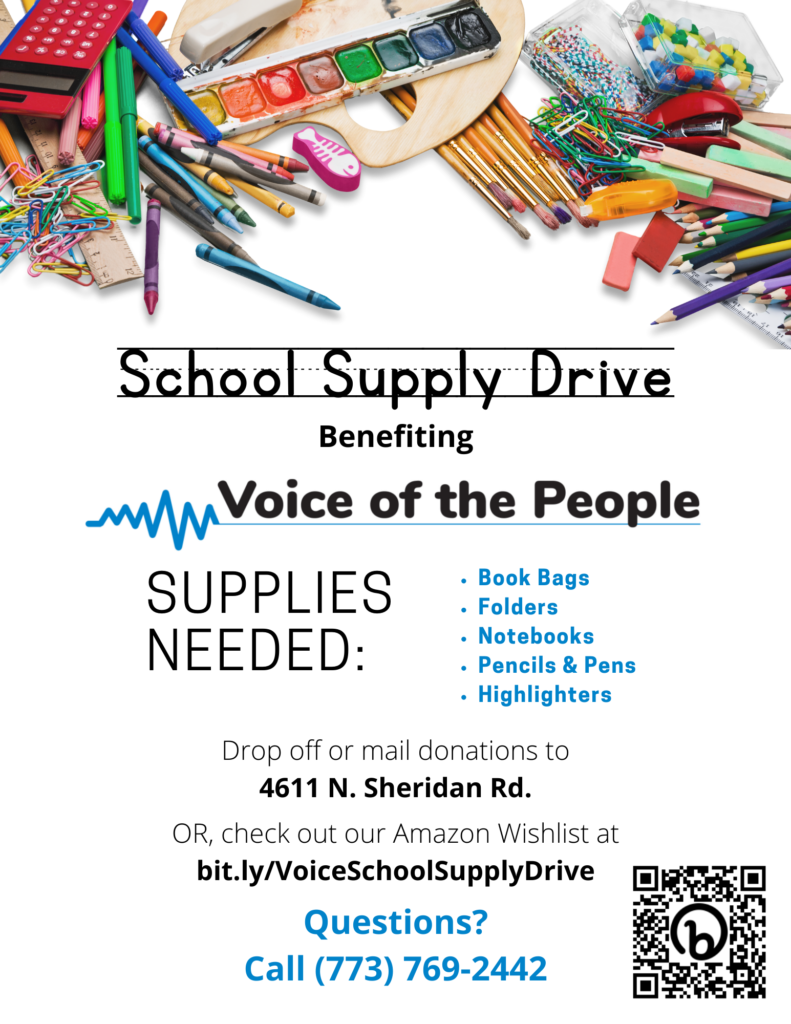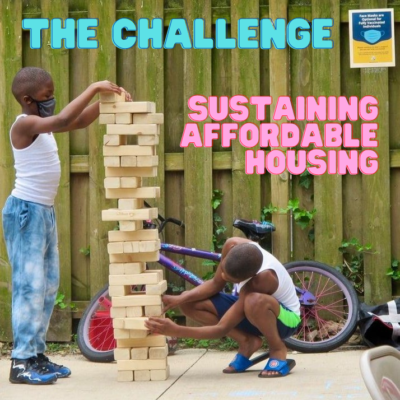
School Supply Drive



Over time, our organization seeks to be a voice and resource center in support of affordable housing residents and owners — so that residents can meet their needs and achieve their goals, and owners can viably continue affordable housing into the future. Our cornerstone program Resident Opportunity Services (ROS) and the newer Voice Owners Network (VON) are programs intended to expedite such services.
Initial VON outreach for owner assistance services is happening now to affordable housing development sponsors in Uptown, as well as private owners who have mixed-income housing with rent subsidies. Priority #1 is supporting our collective interests in achieving property tax relief through valuations and appeals in process with the Assessor’s Office and with appeals agencies like the Cook County Board of Review… favorable taxes helps to maintain affordable housing and sustain racial/economic diversity.
To protect and preserve affordable housing into the future, Voice will seek to help owners, including their asset managers, property managers, and resident service providers, to build their capacity via networking among professionals, and sharing access to information and resources so that they might increase their revenues, decrease their costs, access funding, subsidized financing and technical assistance that makes their affordable housing developments socially and economically sustainable.
Owners, managers and tenant service providers can see our MAKING HISTORY VIDEO, or READ MORE about announcement and proposed networking and services that could be available in the future. People can CALL 773.769.2442 to schedule a brief informational interview about the Voice Owner’s Network, or simply go online to REGISTER specific interests, and stay current with related news and activities.
Sweet Home Uptown Links Tonight, November 18th

Voice of the People in Uptown announces the formation of an Exploratory Committee for the possible establishment of a community land trust — one that would lock in lasting affordability for housing providers. A blue-ribbon panel of affordable housing developers, consultants, lenders and university researchers will advise Voice’s community board with recommendations for the proposed “Diversity Land Trust”. If successful, it might not only benefit Voice and the Uptown community, but be more broadly used in Chicago to support sustainable economic and racial diversity. READ MORE
Updated: September 2021
Senior Support Coach
Resident Opportunity Services (ROS) Program
Starting Pay: $38-42,500with benefits, depending on skills and experience
Position Summary
Under supervision of the ROS program manager, the Senior Support Coach will conduct outreach, provide supportive counseling, enable community building activities, and perform various duties in support of older residents residing in Voice-sponsored affordable housing developments in the Uptown Community. S/he will take a lead role in linking low-income, senior residents and their families to services and opportunities that address social, health, economic, cultural, and recreational needs and interests. The position is full time, with a schedule that is flexible to meet residents’ needs.
Duties and Responsibilities
The Senior Support Coach will
Uptown, Chicago – The RRF Foundation for Aging has awarded community-based nonprofit Voice of the People in Uptown a $50,000 grant in support of the organization’s new Resident Opportunity Services Program that serves the 14 Voice owned and affiliated buildings.
The funding is part of the RRF Foundation for Aging’s priority to support organizations that make housing more affordable and provide coordinated services that enable older people to live safely in community settings and improve the quality of life for older people.
Voice has been providing and advocating for affordable housing in the Uptown and Greater Chicago community for over 50 years. As part of the organization’s strategic plan for the next 50 years, in FY2019 Voice launched its new program Resident Opportunity Services. The program provides and connects Voice’s 214 households with social, cultural, recreational, and economic opportunities to improve residents’ housing stability and overall quality of life.
The grant will increase the program’s capacity allowing for staff to provide senior specific services to the over 40% of Voice households that include at least one household member who is a senior, has a reported disability or health risk. This is one of ten resident identified priority areas for the expansion of Resident Opportunity Services, the need for which became vital after the tragic passing of a long-time Voice resident in the Fall of 2019.
As COVID-19 continues to impact our lives, the colder weather will soon arrive along with the flu season. It will be important to be able to distinguish between these illnesses to help keep you and your family healthy. Here are some frequently asked questions:
What is the difference between Influenza (flu) and COVID-19?
Flu and COVID-19 share many characteristics, but there are some key differences between the two. The key differences between flu and COVID-19 are that COVID-19 seems to spread more easily than the flu and causes more serious illnesses in some people. It can also take longer before people show symptoms and people can be contagious for longer. Another important difference is there is a vaccine to protect against flu. There is currently no vaccine to prevent COVID-19. The best way to prevent infection is to avoid being exposed to the virus.
Here is a detailed list of the similarities and differences between the flu and COVID-19: https://www.cdc.gov/flu/symptoms/flu-vs-covid19.htm
Will there be flu along with COVID-19 in the fall and winter?
While it’s not possible to say with certainty what will happen in the fall and winter, CDC believes it’s likely that flu viruses and the virus that causes COVID-19 will both be spreading. In this context, getting a flu vaccine will be more important than ever. CDC recommends that all people 6 months and older get a yearly flu vaccine.
Can I have the flu and COVID-19 at the same time?
Yes. It is possible to have the flu, as well as other respiratory illnesses, and COVID-19 at the same time. Health experts are still studying how common this can be.
Is COVID-19 more dangerous than the flu?
Flu and COVID-19 can both result in serious illness, including illness resulting in hospitalization or death. While there is still much to learn about COVID-19, at this time, it does seem as if COVID-19 is more deadly than seasonal influenza; however, it is too early to draw any conclusions from the current data. This may change as we learn more about the number of people who are infected who have mild illnesses.
To review more frequently asked questions about this upcoming flu season, here is a link to help you learn more:
https://www.cdc.gov/flu/season/faq-flu-season-2020-2021.htm#anchor_1591372261934